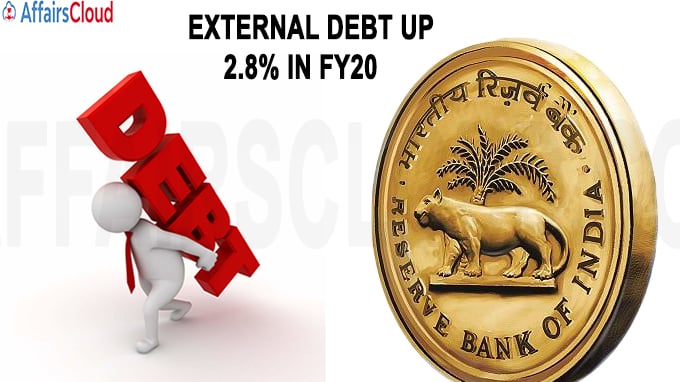 In accordance with the Reserve Bank of India (RBI) data, India’s external debt stood at $558.5 billion in March 2020, an increase of $15.4 billion or 2.8% as compared to the March 2019.
In accordance with the Reserve Bank of India (RBI) data, India’s external debt stood at $558.5 billion in March 2020, an increase of $15.4 billion or 2.8% as compared to the March 2019.
- The largest component of the external debt is Commercial borrowings with a share of 39.4%, followed by non-resident deposits at 23.4% and short-term trade credit at 18.2%.
- In terms of currency, United States (US) dollar-denominated debt continued to be the largest component of India’s external debt, with a share of 53.7% at end-March 2020, followed by the Indian rupee (31.9%), yen (5.6%), SDR (4.5%) and the euro (3.5%).
Key Points regarding external debt:
-There were valuation gains due to the appreciation of the U.S. dollar against the Indian rupee and other major currencies which stood at $16.6 billion. Excluding the valuation effect, the increase in external debt would have been $32 billion instead of $15.4 billion at end-March 2020 over end-March 2019.
–Long-term debt: At the end of March, 2020 long-term debt, with original maturity of above one year, was placed at $451.7 billion, a rise of $17 billion over the level recorded in March 2019.
–Short-term debt on residual maturity basis: It constituted 42.4% of the total external debt and 49.5% of foreign exchange reserves at the end of March, 2020. The ratio of short-term debt (original maturity) to foreign exchange reserves declined to 22.4 per cent at end-March 2020 (26.3 per cent at end-March 2019).
–Short-term debt (with original maturity of up to one year): It declined to 19.1% at end-March 2020 from 20% at end-March 2019
–Outstanding debt: Nonfinancial corporations faced the highest outstanding debt at 42.0 per cent, followed by deposit-taking corporations (except the central bank) (28.3%), general government (18.1%) and other financial corporations (7.5%).
–Instruments: Loans were the largest component of external debt, with a share of 34.8%, followed by currency and deposits (24%), trade credit and advances (18.7%) and debt securities (17.4 %).
–Borrower: Outstanding debt of general government decreased, while that of non-government sector increased at end-March 2020.
-Debt service (principal repayments plus interest payments) increased marginally to 6.5% of current receipts at end-March 2020 as compared with 6.4% at end-March 2019.
-For FY20, the current account deficit narrowed to 0.9% of the Gross Domestic Product (GDP) compared to 2.1% in FY19.
-India’s forex reserves increased by $ 59.5 billion during 2019-20.
About Reserve Bank of India (RBI):
Headquarters– Mumbai, Maharashtra
Formation– 1 April 1935
Governor– Shaktikanta Das
Deputy Governors– 4 (Bibhu Prasad Kanungo, Mahesh Kumar Jain, Michael Debabrata Patra, one is yet to be appointed).




